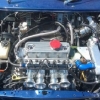carb icing tends not to be an issue on injection.
I know its not a big problem but can occur The main types of icing fall into three catagories.
1. Impact Ice. This is formed by the impact of moist air at temperatures between -10°C and 0°C on air scoops, throttle plates, heat valves, etc. It usually forms whith visible moisture such as rain, snow, sleet. Most rapid accumulation can be anticipated at -4°C. This type of icing can affect fuel injection systems as well as carburettor systems and is also the main type of icing hazard for turbocharged engines.
2. Fuel Ice. This forms at, and downstream from, the point that fuel is introduced into the ITB or carburettor when the moisture content of the air freezes as a result of the cooling caused by fuel vaporisation.
3. Throttle Ice. This is the most common and causes the most problems. It is formed at or near a partly closed throttle valve (sometimes called the “butterfly valve”). The water vapour in the induction air condenses and freezes due to the venturi effect cooling the air as it passes the throttle valve. Since the temperature drop is usually around 3°C, the optimum temperature for forming throttle ice is between 0°C to +3°C although a combination of fuel and throttle ice could occur at higher ambient temperatures.

























